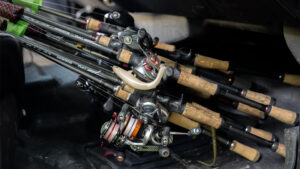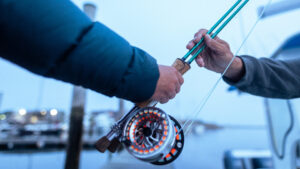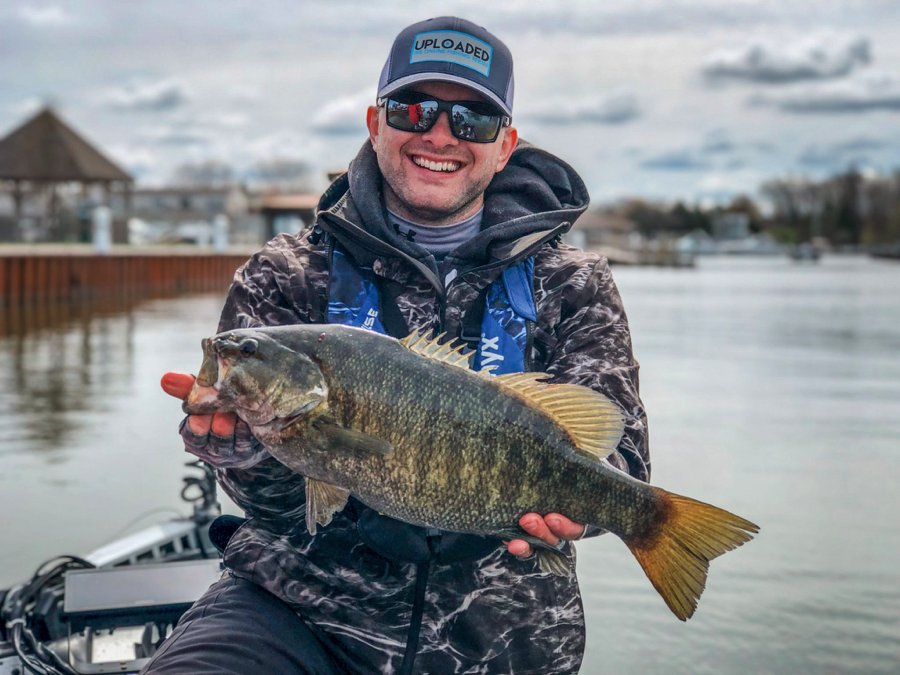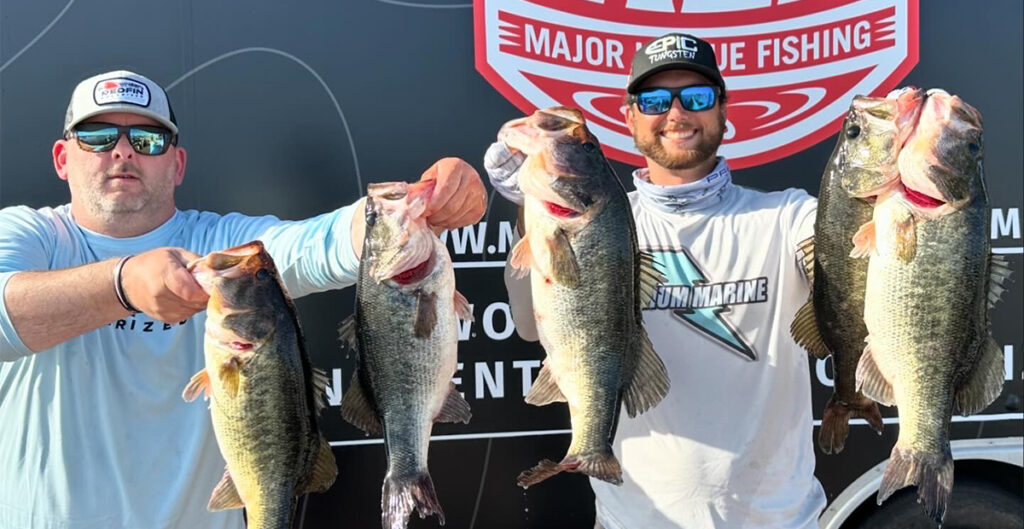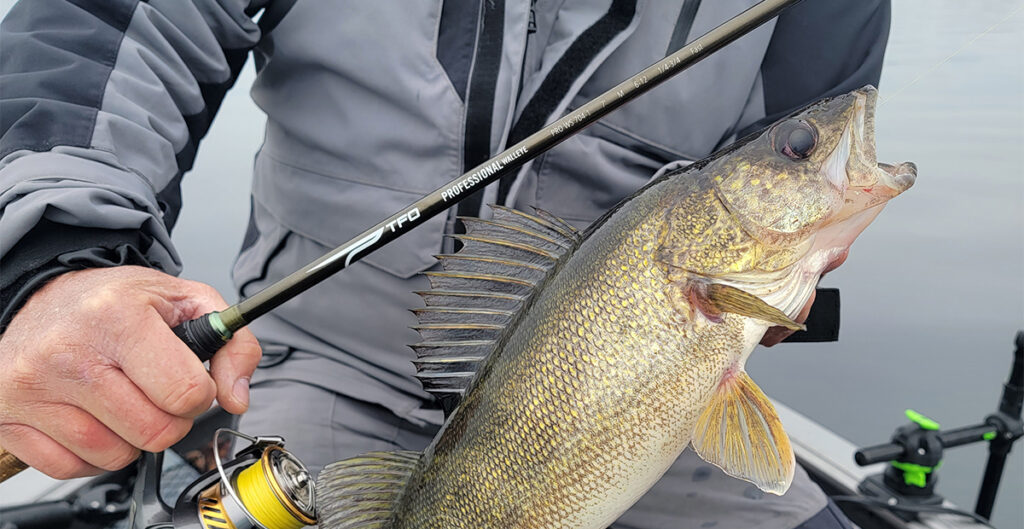Prespawn smallmouth to me is associated with constant movement. The prespawn period is typically when water temps are between mid 40 degrees to upper 50’s, with the “Magic Number” being around 60 degrees for smallmouth to be in full-blown spawn mode. Smallmouth in the prespawn are constantly in transition from deeper waters into staging areas and getting closer towards shallower flats where they will spawn. Smallmouth are unique in the fact that they tend to spawn in deeper water than largemouth and are more willing to be in open water areas near the main lake, as long as they can be protected from the elements; wind, waves, and current. The areas that I’m looking for during the prespawn are areas where fish can transition very easily. Fish want to have easy access between shallow and deeper water areas, especially during early to mid spring while they’re feeding up in the prespawn. Important factors such as weather, water color and temperatures are constantly changing, so being able to adjust to these variables is important for catching more smallmouth.
Ideal Water Temperatures
Typically the ideal prespawn water temperature for smallmouth is in the upper 40s to upper 50s – approximately 48-58 degrees. That’s really when I’m going to consider active prespawn smallmouth fishing. Mid April to mid May is a pretty good gauge for when fish seem to be fully in prespawn mode.
Transition, Contour & Structure
Finding transition points in depth and structure are where smallmouth can be found in early spring. Typically, these transitional staging areas are drops, points, or really any subtle structures on the bottom. Hard spots, or areas where there’s small contour off the edge of a hard drop are great holding spots. Smallmouth on northern lakes tend to set up on obvious contour changes, for example areas where there are steep drops near a main lake point can be very productive locations.

Photo: Ben Nowak
Setups
In order to adapt to the weather, water color and temperatures, and ever-changing moods of smallmouths, I’ll have a variety of baits tied on during the early spring to find smallmouth. The bait that I’ll choose will depend on the situation, fish mood, and water clarity. Having the ability to catch fish on a variety of baits is one of the most fun, but most challenging things during the spring.
1.) Jerkbait with the7’ Medium Cranking Tactical Bass (TAC LW 70CB-1)
The jerkbait is probably my number 1 bait for fishing the prespawn. Jerkbaits work especially well for the Northern lakes that I’m typically fishing this time of year. They catch fish that are both lethargic and don’t necessarily want to eat. A jerkbait elicits more of a reaction strike, but they’re also a really good bait to cover water with and just get really aggressive fish to come up and eat too.
The rod that I prefer to use is the 7’ Medium Cranking Tactical rod (TAC LW 70CB-1). The reason I like this rod is because the action is snappy enough that I can fish the jerkbait well, but when the fish bites, the rod has a deeper bend (more moderate action) to keep these big smallmouths hooked!
2.) Medium Crankbait with the 7’4 Medium Heavy Tactical Elite Bass (TLE LW 74CB-1)
I also really like a medium diving crankbait for covering water in the springtime. Using an 8-12 foot diving crankbait allows me to cover a lot of water to locate these big pods of smallmouth. Once I’ve located the school, I can also use the same bait to trigger fish to bite cast after cast. What I’m looking for when fishing a medium diving crankbait are mid depth contour changes, preferably with isolated cover on bottom. Grass, rock piles, or even subtle bottom composition changes can be the key to finding perfect prespawn smallmouth habitat!
3.) Hair Jig with the 7’6 Medium Light Professional Walleye (PRO WS 763-1)
One of the x-factors during the spring are warm sunny days with light wind. After a long winter under ice up here in the north, fish are seeking warmer water areas, so light wind days with high sun will warm the shallow waters quickly. On days where other techniques seem not to be effective, a small marabou hair jig can be a great way to target these shallow smallmouths that are sunning themselves in warming shallow water.
A big key when fishing a hair jig is the ability to make long casts to isolated targets. Similar to hunting, having a stealthy approach and being able to sneak up on fish is important, so having a longer rod with the right action to cast light baits is paramount. My rod of choice for a 3/32 ounce or ⅛ ounce hair jig is the 7’6” Medium Light Professional Walleye rod. This rod is long enough to allow me to make the long casts that I need, but also soft enough to handle these baits with ease.
When I’m fishing a hair jig, I’m looking for really obvious cover – big boulders, isolated dock posts, or any obvious isolated pieces of cover. My favorite approach to target this shallow cover is to throw the hair jig by these pieces of cover and use a very slow retrieve, just waiting for the rod to load up with a fat prespawn smallmouth.
4.) Swimbait with the 7’5 Heavy Tactical Elite Bass (TLE FS 756-1)
Last but not least is a soft plastic swimbait. Of all of the approaches, a 3.5” soft plastic swimbait is one of the most versatile baits that I will throw in the prespawn. This is a lure that you can do just about anything with, from slow rolling in deeper water to swimming high in the water column, a swimbait can be used in a variety of situations. When choosing swimbait colors, I keep things simple in the prespawn; white or shad based colors in clear water situations and darker green based colors when the water gets slightly off-colored or has a stain to it. With these two colors, you can approach a variety of water clarities with success.
With a swimbait, let the approach dictate the size jighead that you choose to use. For smallmouth around open water I’m typically using an open-hook jighead. This allows the best hookup to land ratio, and is my preferred method.
Although these are setups that I use for smallmouth in Michigan, you can use these same setups in other smallmouth fisheries and have success anywhere that smallmouth swim.
Key Takeaways
The biggest things to prespawn smallmouth fishing is covering water and finding where they are staging. A lot of times where there is one smallmouth in the prespawn, there tend to be many! Cover water until you find them and then slow down and pick them apart.
Blog written by Midland, Michigan based TFO Ambassador Ben Nowak. You can find out more about Ben by visiting and subscribing to his YouTube channel here or following him on social media here.
![]()
